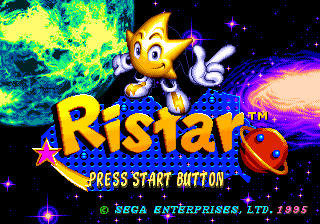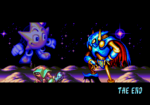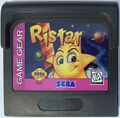Ristar
From Sega Retro
| Ristar |
|---|
| System(s): Sega Mega Drive/Genesis, Sega Game Gear |
| Publisher: Sega |
| Developer: Sonic Team |
| Genre: 2D Platform |
|
CERO
Missing Parameter! |
Ristar (JP version: Ristar - The Shooting Star) is a platform game developed by Sonic Team released for the Sega Genesis and the Sega Game Gear. It was one of the last Genesis games published and therefore never got much exposure compared to similar platform games released for the same consoles. It was re-released in 2002 (JP, NA) / 2003 (EU) as part of the Sonic Mega Collection on the Nintendo GameCube and in 2004 (JP, NA) / 2005 (EU) as part of the Sonic Mega Collection Plus on the Sony PlayStation 2 and the Microsoft Xbox. To play Ristar in the GC edition, you must play all the default games 30 times each; in the PS2/Xbox edition, you must play them 20 times each.
Contents
Storyline
In Ristar, we follow the story of a far away solar system, Valdi, that was corrupted by an evil tyrant called Greedy. Greedy forced the leaders of each of the seven planets the system is composed of to work for him, enslaved the people and kidnapped Ristar's father. Desperate, they make a plea for help. It is answered by Ristar, a tiny humanoid yellow star with long, elastic arms. To free the population and liberate his father, Ristar must fight Greedy's minions throughout every planet, restore the leaders and eventually fight Greedy himself.
Gameplay
Ristar, unlike Sonic, can't look up nor down and can only jump about his own height. Ristar's main ability, then, are his arms. To kill enemies, you must grab them with Ristar's stretchy arms and after releasing the grab button Ristar will headbutt the enemy. This is the only way to eliminate enemies as jumping on them will not work. Ristar's arms can also be used to ride spinners (these are used to move from one location to another without having to walk), climb walls, swing across poles and even find bonuses (health points, 1UPs, etc.) by stretching them into tiny breaches in walls. (You may also find them by headbutting certain sections of certain walls.)
Ristar is very different from Sonic in one aspect, however, and that is Ristar's ability to explore worlds underwater without needing to breathe. He can also swim underwater with ease.
The game has a simple health system: the player starts with 4 or 2 stars (depending on the difficulty selected), the max number of stars is 4. Every time you're hit, you lose one star. There are situations where you'll lose all your health, but these are rare. You may replenish health by getting the star pickups: a yellow star pickup will provide you with 1 star and a blue star pickup 4 stars. Ristar also has a very basic life/continue system: once you lose all of your lives, you'll be taken to a continue screen where you can choose to keep going with the game or give up. You may earn more continues by ending the special stages quickly and more lives by getting the tiny Ristar doll pickup. (Every 30,000 points you earn are also worth 1UP.)
Earning points comes mainly from toppling enemies (generally gives you 100 points) and yellow gems which are worth between 100 and 1000 points, depending on how hard they are to reach.
Levels
| 120px | Planet Flora is the first level of Ristar, and is a generic tropical island cliché, with lots of vegetation similar to the flora found in Sonic games. It is pretty easy and mainly about getting used to the controls. The second zone includes a darker jungle setting. Riho, the boss of Flora, is also easy to defeat. |
| 120px | Planet Undertow is the aquatic ruin level where nasty fish foes abound. This planet gives you the opportunity to try out Ristar's underwater swimming abilities, though be aware it's rather tricky to grab things here. The background in the first zone, like in Planet Flora, is a bit lighter than in the second zone, which is made of a totally submerged series of tunnels, with few to no dry land. The boss here is Ohsat, a hammerhead shark. |
| 120px | Planet Scorch follows the archetype of the fiery industrial world and is considerably harder than the previous planets. The second you land on the planet you'll face a rain of flaming meteors which only goes away a few seconds after. Scorch also requires a high level of mastery of all the basic skills (jumping and grabbing). There's a mini-boss involving a memory game between the two zones. The boss is Adahan, a huge robot mole. |
| 120px | Planet Sonata is considered by many players the most creative stage in Ristar—even one of the most original stage to ever appear in a platform game at that time. Sonata revolves solely around music and the level is vastly decorated in a musical theme: grabbing poles are flutes and, handholds are trumpets and enemies even launch dangerous musical notes at you! The first zone (which takes in a strangely futuristic background) is made of four sections and in each of these sections there's a very singular objective: deliver metronomes to the songbirds so you may advance through the level. The mini-boss consists of toppling three mechanic bird heads. The second zone is much more related to disco/dance, especially the background music, though apparently it takes place in some kind of dark castle or chamber. Awaunek, a giant hawk, is Sonata's boss. |
| 120px | Planet Freon is an ice planet. The first zone is child's play, with lots of spinners and slippery floors. Throughout all of this zone you'll be closely followed by a strange alien who you'll fight at the end in a peculiar snowball fight. The second zone is nowhere as easy and consists mostly of swimming around in near-frozen water. In the boss zone, the strange alien guy who stalked you during the first zone will actually aid you in defeating him—this is done by hurling steamy pizzas (pies?) provided by him into Itamor's (the boss) mouth. |
| 120px | Planet Automaton is a mixed bag: the second zone and the boss to some extent are a pushover, though the first zone is incredibly challenging—it is also somewhat similar to mechanical levels in Sonic games like Scrap Brain Zone and Metropolis Zone. Automaton's boss is Uranim. |
| 120px | Greedy's Spaceship is where the last fight with Greedy happens, although you will still have to go through another mini-boss before him. |

|
In bonus rounds, you will have one minute to attain a treasure chest and collect one item; the first bonus round is very easy and consists of only one spinner but they eventually get more and more bothersome. You only have one try for each bonus round. Also, completing them very rapidly will get you one free continue. The items in the treasure chests are useless themselves but in the end of the game if you have enough of them you'll earn secret passwords. |
JP version secrets
The JP version of Ristar was not only released with a different title but with secret characters, among other things. One of the most well-known secrets was the intro: you can see a huge green star being—supposedly Ristar's father/mother just before Ristar is awakened by the plea of help from the populace. Actually, the green being is known as Oruto, who has a cluster of stars. She selected Ristar to fight Greedy. The ending was also different since you don't see Ristar running to his father's arms.
Connections with Sonic
Ristar's gameplay alone has garnered it lots of comparisons to the early Sonic games. The most significant link between Ristar and Sonic is the fact that Ristar was built on the Sonic 1 engine, including the level engine and music engine. Another strong link to Sonic was the prototype design of Ristar, named Feel — the character had a striking resemblance to Sonic, being a spherical yellow and black "rabbit," and even had identical shoes. Ristar also performed cameos along with other Sega characters in Shenmue and Segagaga.
Production Credits
Producers: Hiroshi Aso, Makoto Oshitani, Youji Ishii, Minoru Kanari
Game Planners(Directors): Akira Nishino, Takeshi Niimura
Project Director: Atsutomo Nakagawa
Art Director: Yukio Sato
Chief Designer: Takumi Miyake
Character Designer: Yuji Uekawa
Planet Designers: Koki Mogi, Kazuyuki Iwasawa, Mikiharu Ooiwa
Character Voice: Eriko Handa
Music Composer: Tomoko Sasaki
Sound Programmers: Hiroshi Kubota, Tatsuya Kousaki
Boss Programmer: Hiromasa Kaneko
Player Programmer: Shigeru Yoshida
Enemy Programmer: Maomi Hirai
Effects Programmer: Takuya Matsumoto
Manual Director: Hiroyuki Mitsui
Manual Designer: Yukiko Yahagi
Manual Writer: Chieko Nakamura
Test Players: Norihiro Sekine, Haruyuki Hashimoto, Hideki Yokaichiya
Special Thanks: Osamu Hori, Kenji Morita, Naofumi Hataya, Masafumi Ogata, Naoko Hamada, Toshiko Arisaka, Rica Terajima, Ryoichi Hasegawa
Sega of America, Inc.
Producer: Rhonda Van
Assistant Producer: Erik Wahlberg
Marketing Product Manager: Pamela Kelly
Lead Tester: Marc Dawson
Assistant Lead Tester: Lance Nelson
Created By: Sonic Team
Presented By: Sega
Production Credits (Game Gear Version)
Game Planner(Director): Nencoo Gutoku
Project Director: Capt. Jinguji
Art Director: Nencoo Gutoku
Character Designers: Francis. N, Pixy Monty
Planet Designers: Mauo. S, General Kusumi
Music Composers: Chikayo Fukuda, Tomoko Sasaki
System Programmer: Alice Kagamino
Ristar Programmer: Mika Muraoka
Boss Programmer: Haruo Nakajima
Enemy Programmer: Ezachan
Effect Programmer: Masami Tezuka
Demo Programmer: Hanamogera. D
Sound Programmer: Kazune Hiiragi
Lead Tester: Matt Underwood
Assistant Lead Testers: Carey Camacho, David Dodge
Special Thanks: Nag, Bryan. M, Wadachi, Tarachan, Chikyuchan, Tanachan, Nana Kusunoki
Sega of America, Inc.
Producer: Rhonda Van
Assistant Producer: Erik Wahlberg
Marketing: Chrissie Huneke-Kremer
Created By: Sonic Team
Presented By: Sega
Physical Scans
Sega Mega Drive
Sega Game Gear
External Links
- GameFAQs Entry
- GameSpot Entry
- Ristar Cluster - Fansite










